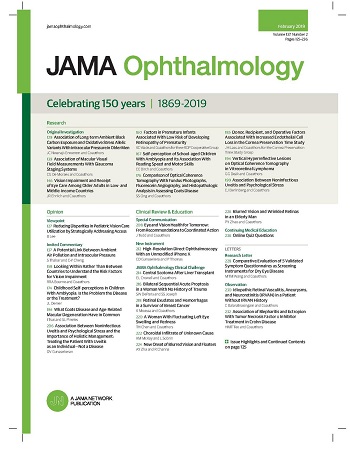长期使用大麻和术后增殖性玻璃体视网膜病变的风险。
IF 7.8
1区 医学
Q1 OPHTHALMOLOGY
引用次数: 0
摘要
增殖性玻璃体视网膜病变(PVR)是视网膜脱离(RD)修复失败的主要原因,导致视力不佳。大麻的使用在全球范围内持续增加,并可能通过其抗炎和神经保护特性影响PVR的发展,尽管这种关联尚不清楚。目的评估并发大麻患者进行初级RD修复后发生PVR的风险。设计、环境和参与者本回顾性队列研究检查了2005年2月1日至2025年2月1日期间多中心研究网络的电子健康记录数据。参与者是接受了最初的视网膜视网膜修复术,包括玻璃体切割(PPV),有或没有巩膜扣(SB)、原发性SB或气动视网膜固定术的患者。这些记录被用来识别被诊断患有伴随性大麻相关疾病的患者,并与没有记录使用大麻的对照组进行了尿液或血液中的大麻确认测试。排除标准为有增殖性糖尿病视网膜病变病史或随访时间少于6个月。初级RD修复与大麻相关疾病。主要结局指标:随访6个月和1年发生PVR并需要后续复杂RD修复的相对风险(RR)。结果倾向评分匹配后,每个队列有1193例患者。平均(SD)年龄为53.2(16.1)岁;男性1662例(69.7%),女性641例(26.9%),性别未知83例(3.5%)。在6个月时,同时使用大麻并以任何方法修复RD的患者发生后续PVR的风险降低(25次事件[2.10%]vs 52次事件[4.36%];RR 0.48;95% ci, 0.30-0.77;P = .002),需要复杂的RD修复(37例[3.10%]vs 60例[5.03%];RR 0.62;95% ci, 0.41-0.92;P = .02)。两种结果在1年后观察到相似的结果。与没有大麻暴露记录的匹配患者相比,接受首次RD修复并同时使用大麻的患者发生PVR和随后需要复杂RD修复的可能性较小;然而,比率的绝对差异很小。虽然这种与大麻使用有关的保护性联系可能是由于使用大麻的人群,而不是大麻本身的影响,但研究结果表明,大麻使用可能在减少PVR的发展中起作用。需要进行干预试验以控制混杂因素。本文章由计算机程序翻译,如有差异,请以英文原文为准。
Long-Term Cannabis Use and Risk of Postoperative Proliferative Vitreoretinopathy.
Importance
Proliferative vitreoretinopathy (PVR) is a major cause of retinal detachment (RD) repair failure, resulting in poor visual outcomes. Cannabis use continues to increase globally and may affect PVR development through its anti-inflammatory and neuroprotective properties, although this association remains unclear.
Objective
To assess the risk of developing PVR among patients with concomitant cannabis use who underwent primary RD repair.
Design, Setting, and Participants
This retrospective cohort study examined data from electronic health records for a multicenter research network extracted for the period February 1, 2005, to February 1, 2025. Participants were patients who underwent initial RD repair with pars plana vitrectomy (PPV) with or without scleral buckle (SB), primary SB, or pneumatic retinopexy. The records were used to identify patients diagnosed with concomitant cannabis-related disorder together with confirmatory testing of cannabis in urine or blood compared with a control group without documented use. Exclusion criteria were a history proliferative diabetic retinopathy or less than 6 months of follow-up.
Exposures
Primary RD repair and cannabis-related disorder.
Main Outcome Measures
Relative risk (RR) of developing PVR and requiring a subsequent complex RD repair at 6 months and 1 year of follow-up.
Results
After propensity score matching, each cohort had 1193 patients. The mean (SD) age was 53.2 (16.1) years; 1662 were male (69.7%), 641 were female (26.9%), and for 83 patients (3.5%), the sex was unknown. At 6 months, patients with concomitant cannabis use with RD repaired by any method had a reduced risk of developing subsequent PVR (25 events [2.10%] vs 52 events [4.36%]; RR, 0.48; 95% CI, 0.30-0.77; P = .002) and requiring complex RD repair (37 [3.10%] vs 60 [5.03%]; RR, 0.62; 95% CI, 0.41-0.92; P = .02) when compared with controls. Similar results were observed at 1 year for both outcomes.
Conclusions and Relevance
Patients who underwent initial repair for RD with concomitant cannabis use were less likely to develop PVR and require subsequent complex RD repair compared with matched patients without documented cannabis exposure; however, the absolute difference in rates was small. While this protective association noted with cannabis use could be due to the population using it rather than an effect of the cannabis itself, the findings suggest that cannabis use might have a role in reducing PVR development. Intervention trials would be needed to try to control for confounding factors.
求助全文
通过发布文献求助,成功后即可免费获取论文全文。
去求助
来源期刊

JAMA ophthalmology
OPHTHALMOLOGY-
CiteScore
13.20
自引率
3.70%
发文量
340
期刊介绍:
JAMA Ophthalmology, with a rich history of continuous publication since 1869, stands as a distinguished international, peer-reviewed journal dedicated to ophthalmology and visual science. In 2019, the journal proudly commemorated 150 years of uninterrupted service to the field. As a member of the esteemed JAMA Network, a consortium renowned for its peer-reviewed general medical and specialty publications, JAMA Ophthalmology upholds the highest standards of excellence in disseminating cutting-edge research and insights. Join us in celebrating our legacy and advancing the frontiers of ophthalmology and visual science.
 求助内容:
求助内容: 应助结果提醒方式:
应助结果提醒方式:


